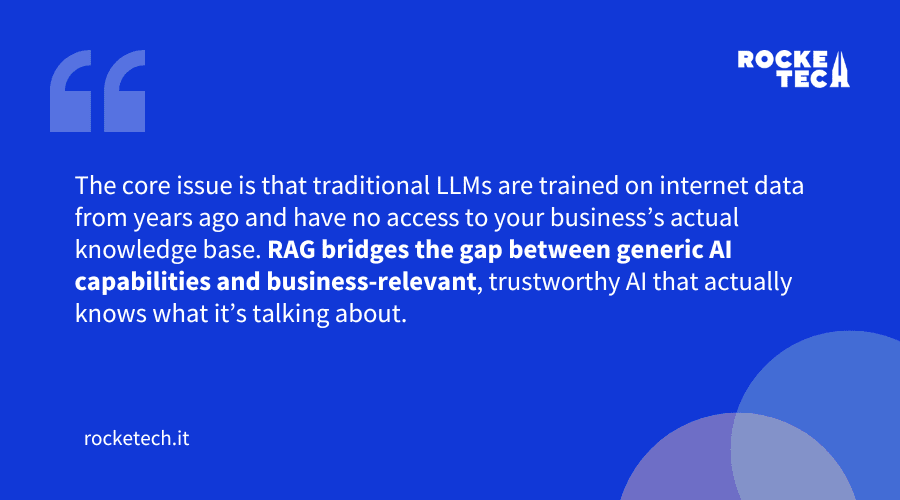While AI chatbots can write poetry and explain complex theories, they fail spectacularly when asked about your company’s specific policies, current product features, or industry regulations. This gap between impressive AI capabilities and actual business needs is costing companies money, trust, and competitive advantage.
RAG (Retrieval-Augmented Generation) solves this problem by connecting AI to your business knowledge, creating solutions that are both intelligent and reliable. This guide explains RAG for business application development, why it matters, and practical steps to implement it across different industries.

The Problem With Today’s AI
Large language models are impressive. ChatGPT can write poetry, explain quantum physics, and debug code. But ask it about your company’s specific return policy, last quarter’s sales data, or compliance requirements for your industry, and you’ll get educated guesswork at best.
This creates real business problems. Companies implementing AI solutions face a frustrating reality: generic AI models hallucinate answers, lack access to proprietary knowledge, and create compliance nightmares when they confidently state incorrect information to customers or employees. A customer service bot that gives the wrong warranty becomes a legal liability.
The core issue is that traditional LLMs are trained on internet data from years ago and have no access to your business’s actual knowledge base. RAG bridges the gap between generic AI capabilities and business-relevant, trustworthy AI that actually knows what it’s talking about.

What Is RAG, Really?
In simple words, Retrieval-Augmented Generation lets AI consult your company’s documents, databases, and knowledge base instead of guessing from its pre-training data.
Think of it like hiring a well-spoken intern who actually reads the manual before answering questions. Instead of improvising responses based on general internet knowledge, RAG-powered AI first searches through your approved documentation, pulls relevant information, and then formulates responses based on that specific data.
The formula is straightforward: LLM + Your Business Data + Smart Search = RAG
When a user asks a question, the system searches your knowledge base for relevant information, feeds that context to the language model, and generates a response grounded in your actual business data rather than hallucinated information.

Why Should Businesses Care?
Deploying “naked LLMs” without RAG creates substantial business risks. Wrong answers damage customer trust. Hallucinated information can violate compliance requirements in regulated industries. Customer frustration mounts when AI assistants confidently provide outdated or incorrect information.
| Imagine a fintech startup that deployed a customer support chatbot using a standard LLM. Within the first week, the bot confidently told customers they could withdraw from retirement accounts without penalties (based on outdated tax code from its training data), promised loan approval rates that no longer existed, and referenced a mobile app feature that was discontinued months ago. Customer complaints flooded in, the compliance team panicked about potential regulatory violations, and the founders had to pull the bot offline while dealing with angry customers who made financial decisions based on incorrect AI advice. |
RAG mitigates these risks while delivering better business outcomes. Сustom AI solutions for business knowledge base become more accurate because they reference authoritative sources. They stay current because they pull from live databases and updated documents. Most importantly, they become trustworthy enough for customer-facing applications and sensitive business processes.
RAG also offers a practical advantage: it’s faster to implement than building custom AI models from scratch. Instead of training an entirely new model on your data — a process requiring significant time, expertise, and computational resources — RAG leverages existing powerful models while connecting them to your business knowledge.
We’ll show you how to build it.
Industry-Specific Examples and Ideas
RAG implementation looks different across industries, but the core principle remains the same: connecting AI to your business-specific knowledge creates competitive advantages. Here are concrete examples of how companies in different sectors are using RAG to solve real problems and build better products.
Finance
Financial institutions need AI that understands current regulations, product offerings, and compliance requirements. Using AI chatbot development with RAG technology, businesses can build customer support bots that pull directly from compliance-approved knowledge bases. This way, responses meet regulatory standards while providing accurate information about loan terms, investment options, and account policies.
Actionable Idea for Fintech
Build a RAG-powered assistant that helps loan officers access up-to-date product information and regulatory guidelines during customer consultations, improving both accuracy and compliance.
Healthcare
Clinical decision support tools powered by RAG can pull from approved medical literature, internal treatment protocols, and patient data to assist healthcare providers. Patient-facing applications can answer common questions by referencing validated medical sources, reducing liability while improving patient education.
Actionable Idea for Healthtech
Develop a patient portal chatbot that answers frequently asked questions about procedures, medications, and post-treatment care using only your medical center’s approved documentation and protocols.
SaaS
Software companies struggle with keeping customer support current as products evolve rapidly. RAG-enabled in-app help assistants can reference the latest release notes, feature documentation, and troubleshooting guides to provide accurate guidance that matches the current product version.
Actionable Idea for SaaS Products
Create an onboarding assistant that walks new users through your latest features using current product documentation, eliminating confusion caused by outdated help content.
HR
Human resources departments manage constantly changing policies, benefits information, and compliance requirements. RAG-powered internal assistants can automate policy questions for employees while ensuring responses reflect current company guidelines and legal requirements.
Actionable Idea for HR Tech
Deploy a recruiting assistant that matches candidates to open positions based on current job descriptions, team composition data, and updated hiring criteria rather than generic job matching algorithms.
Edtech
Educational technology platforms can use RAG to create personalized tutoring experiences that reference specific curricula, teacher-uploaded materials, and institutional learning objectives. This ensures students receive help that aligns with their actual coursework rather than generic educational content.
Actionable Idea for Edtech
Build a homework assistant that answers student questions using your school’s specific textbooks, curriculum materials, and teacher guidelines rather than pulling answers from random internet sources.

How to Get Started With RAG
Understanding RAG’s potential is one thing — actually implementing it successfully is another. Many businesses jump into RAG startup implementation without proper planning, leading to disappointing results and wasted resources. Here’s a practical roadmap for building RAG solutions that actually work for your business.
1. Evaluate Your Business Case
Identify where inaccurate or outdated information currently hurts your business most. Customer support tickets about product features? Employee confusion about policies? Compliance concerns with current AI tools? Start where the pain is greatest.
2. Inventory Your Knowledge Sources
Document databases, wikis, policy manuals, product documentation, FAQ databases, and internal communications all become potential data sources for RAG implementation. The quality of your RAG system depends heavily on the quality and organization of this source material.
3. Partner Strategically
RAG implementation requires understanding both the technology and your specific compliance needs. Look for development teams experienced in building RAG systems for your industry who understand data security, regulatory requirements, and business integration challenges.
4. Start Small and Scale Gradually
Pilot RAG implementation for startup products with a single use case. Perhaps internal policy questions or specific customer support topics. Measure accuracy, user satisfaction, and business impact before expanding to more complex applications or customer-facing systems.
| The key is treating RAG implementation as a business transformation project, not just a technical integration. Success requires careful attention to data quality, user experience, and ongoing maintenance of your knowledge base. |
Summing Up: The Future Is Augmented
RAG isn’t optional for businesses that want AI solutions actually working for their specific needs rather than against them. Generic AI models will continue improving, but they’ll never understand your business context, current policies, or proprietary processes without augmentation.
Companies implementing RAG early are building competitive advantages through smarter customer service, more efficient internal operations, and AI-powered products that customers can actually trust. They’re creating digital experiences that feel intelligent and relevant rather than impressively generic.
The question isn’t whether your business will eventually need RAG-powered solutions but whether you’ll implement them before or after your competitors do. In a market where customer expectations for intelligent, personalized digital experiences continue rising, augmented AI isn’t just better technology. It’s better business.
Let us guide you through implementation.